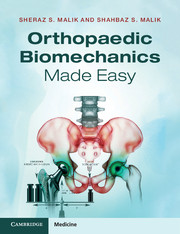Book contents
- Frontmatter
- Dedication
- Contents
- Contributors
- Epigraph
- Preface
- Acknowledgements
- Part I Orthopaedic biomaterials and their properties
- 1 Introduction to orthopaedic biomechanics
- 2 Orthopaedic biomaterials and their properties
- Part II Engineering theory applied to orthopaedics
- Part III Clinical biomechanics
- Index
- References
2 - Orthopaedic biomaterials and their properties
from Part I - Orthopaedic biomaterials and their properties
Published online by Cambridge University Press: 05 June 2015
- Frontmatter
- Dedication
- Contents
- Contributors
- Epigraph
- Preface
- Acknowledgements
- Part I Orthopaedic biomaterials and their properties
- 1 Introduction to orthopaedic biomechanics
- 2 Orthopaedic biomaterials and their properties
- Part II Engineering theory applied to orthopaedics
- Part III Clinical biomechanics
- Index
- References
Summary
Structure and properties of materials
Our world is full of objects. These objects are made of different materials, which are composed of different internal microscopic structures. Therefore, all objects can be analysed in terms of their molecular arrangement. The properties and behaviour of materials is determined by the following structural factors:
types of bonds between atoms, e.g. ionic or covalent
arrangement of atoms, e.g. short molecules or long chains
microstructure, e.g. crystalline or amorphous
macrostructure, e.g. single crystal or polycrystalline.
This structural hierarchy divides all materials into four groups: metals, ceramics, polymers and composites. Materials in each group have similar molecular structure and therefore exhibit a similar range of properties. Material properties can be divided into chemical, physical, electrical and mechanical. These properties define how different groups of materials can be applied in the physical world.
A biomaterial is any substance, natural or engineered, that forms a part of either a biological structure or a biomechancial device that augments or replaces a natural function. All of the four groups of materials may be used as biomaterials. However, the properties of a material must be compatible with the body for it to be used as a biomaterial. Mechanical properties determine if a material can withstand applied loads and therefore define its practical functional capacity. Mechanical properties can be divided into two groups: static and viscoelastic (time-dependent). Static properties include stiffness, strength, ductility, toughness and hardness. Viscoelastic properties include fatigue, creep, stress relaxation and hysteresis. All these variables are just different measures of how the material deforms under load. This chapter looks into how the molecular structure of different groups of materials determines their mechanical properties and their applications in orthopaedics.
- Type
- Chapter
- Information
- Orthopaedic Biomechanics Made Easy , pp. 24 - 48Publisher: Cambridge University PressPrint publication year: 2015



